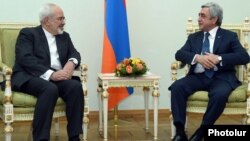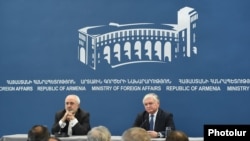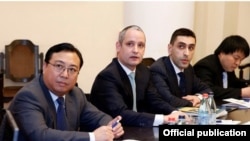Iranian Foreign Minister Mohammad Javad Zarif spoke of further progress made towards the construction of a railway connecting his country to Armenia and the implementation of more Armenian-Iranian energy projects as he visited Yerevan on Tuesday.
Meeting with President Serzh Sarkisian, Zarif was reported to describe Armenia as a “trustworthy partner” and reaffirm the Iranian leadership’s commitment to deepening bilateral ties “in all areas” and “without limits.”
“Foreign Minister Zarif emphasized that Armenian-Iranian relations can serve as a good example for the outside world of how Islamic and Christian countries can peacefully co-exist side by side,” Sarkisian’s press office said in a statement. The statement said the two men agreed that the joint energy and transport projects would further strengthen that relationship.
Speaking after his separate talks with Foreign Minister Edward Nalbandian held earlier in the day, Zarif stressed the importance of the planned construction of a big hydroelectric plant on the Armenian-Iranian border and a third high-voltage transmission line that will connect the power grids of the two neighboring countries.
The Armenian and Iranian transport ministers announced in Tehran last month that work on the power line, which should lead to a sharp increase in Armenian electricity exports to the Islamic Republic, will get underway in March. They also said that an Iranian company will likely start building the Arax river plant by early 2016.
“There is definitely the political will to push forward the implementation of economic projects between Armenia and Iran,” Zarif told a joint news conference with Nalbandian. “We have overcome some technical issues.”
“As regards the railway, there have been very good trilateral discussions and good decisions and we hope that [the project] will quickly move forward,” he said.
The 470-kilometer railway, which would mainly pass through Armenian territory, has been planned by the two sides ever since the late 1990s. The extremely ambitious project has yet to get off the drawing board mainly because of Yerevan’s failure to attract an estimated $3 billion needed for building the Armenian section of the strategic transport link.
In 2013, the Armenian government granted Rasia FZE, an investment company based in Dubai, a 30-year concession to build and manage the 305-kilometer section. Rasia in turn contracted the China Communications Construction Company (CCCC) group to conduct a feasibility study and recommend a cost-effective route for the railway.
Joseph Borkowski, the Rasia chairman, visited Yerevan in February 2014 to present the final results of the study to then Prime Minister Tigran Sarkisian. Borkowski reportedly said that the construction could in 2016 and take six years.
According to Deputy Transport Minister Artur Arakelian, Rasia has been holding “very active negotiations” with Chinese investors interested in financing the railway’s construction. Arakelian said that investors from other nations, notably Russia, may also show an interest in the expensive project worth almost as much as Armenia’s entire 2015 state budget. He declined to name any of those investors.
Speaking to RFE/RL’s Armenian service (Azatutyun.am) shortly after Zarif’s news conference, Arakelian also said that he discussed the matter in detail with Iranian officials during a November visit to Tehran. He said they finalized an agreement that commits Iran to starting to build its section of the rail link immediately after 30 percent of the construction work on the Armenian side is complete.
In a September 2013 statement, Rasia affirmed the “strong economic viability and regional importance of the railway,” saying that it would create the shortest transport route between Persian Gulf and Black Sea ports. “The Southern Armenia Railway will establish a major commodities transit corridor between Europe and the Persian Gulf region, with conservative long-term traffic volume forecasts of 18.3 million tons per annum,” it said.
The railway would mainly run through Armenia’s mountainous Syunik province bordering Iran. Hence the very high cost of construction, which has long raised doubts about its feasibility. According to Rasia, the railway would have 84 bridges and 60 tunnels with a total length of more than 100 kilometers.






